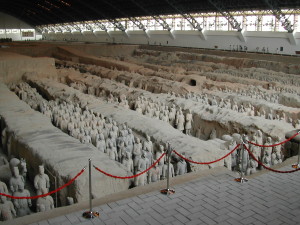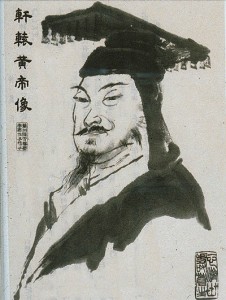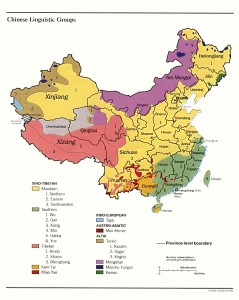The Linguistic Complexity of China
The Chinese language has many different regional accents. This is so for a number of reasons, primary among them being that for many (actually most) Chinese, the fact is that Pǔtōnghuà (‘common language’, and known in the West as ‘Mandarin’) is actually a second language, and not their mother tongue!
China is linguistically a very complex place because of its history. It has been an empire for over 2000 years, since unification in 221 bce by the Qín (pronounced Chín) Emperor (Qín Shǐ Huángdì, aka the ‘First Emperor’: see the drawing to the left).
Qín used to be transliterated as ‘Ch’ín’ in the Wade-Giles System from which, the legend goes, comes the name ‘China’. (This seems to be a somewhat apocryphal legend, however, since the name ‘China’ considerably predates the creation of the Wade-Giles transliteration system.)
While the Qín Emperor is primarily remembered as the conqueror who first united China, he is also famous for the imposition of uniformity in China: among other things in currency, weights and measures and in the wheelbase of wagons, and, because many of the Kingdoms of that era had their own languages, (which today are known as ‘provincial languages’), he required that all the kingdoms he conquered, (and not just his own Hàn people) speak the Hàn language (now known as Chinese).
While scholars may argue about whether these languages are dialects, degraded forms or a family of related languages, no matter.
Many Americans will be familiar with one of the major of China’s provincial languages (spoken by approximately 80-100 million people in China) simply because it has long been spoken in most of the Chinatowns in US coastal cities.
Most of the Chinese immigrants to the US in the 19th and a good part of the 20th centuries came from Hong Kong and Guǎngdōng (Canton) province and spoke Cantonese in preference to Pǔtōnghuà. In fact, many Chinese-born Cantonese immigrants to the U.S. before the 1960’s didn’t even speak Pǔtōnghuà at all.
Cantonese is known to the foreign listener by its sing-song sound …it is an 8-tone language and sounds substantially different from all other Chinese languages- even other 8-toned ones.
Historically, only the people in Northeast China (generally speaking, the area from the Beijing-Tianjin corridor to the east and north), speak Pǔtōnghuà as a native language, (having given up their former language, Manchu, over the course of the 18th and 19th centuries during the Qīng dynasty.) This is a very broad generalization, as there are other areas in China where Chinese do speak Pǔtōnghuà as a native language, although these areas are usually in large cities.
Note that the concept of ‘native-speaker’ of the Chinese language as used on this website is a little bit imprecise. The term ‘native-speaker’ is used on this website with a broad meaning of any Chinese person, even if his or her mother tongue is actually a provincial or place-language (see the following section).
Provincial and ‘Place-Languages’ and Chinese Regional Accents
Most Chinese people speak either their provincial language as a native language, or that other Chinese innovation called a ‘place-language’ (this is a literal translation of the Chinese word “fāng yán” [方言], which is usually translated as “dialect” in English, and is purposely mistranslated here to indicate the literal fact that these languages are limited to a small area, or ‘place’.).
A place-language could also be called a ‘local’ or ‘city’ language, as its use is often limited to a city and its surrounding area …and many (if not most) large cities in China have them. (Note that place-languages are classified as dialects of Chinese and are usually unintelligible to each other.)
Place-languages and provincial languages are also usually unintelligible to each other, and generally speaking, are different from each other.
As an example of the linguistic complexity of China, you might have one village in Guǎngdōng (Canton) province that speaks Cantonese, and a village within a few miles of it that speaks Hakka …a completely different language.
Note here that for historical reasons, Hakka is actually a separate provincial language and not a place-language, even though Hakka people and the Hakka language coexist with Cantonese in Guǎngdōng province, with Fujianese in Fújiàn province, and with the people and provincial language of Jiāngxī (pron.: Jiang shee) province, (all provinces in south China) as well as with Taiwanese in Táiwān.
As a further example of place-languages, two of China’s great and well-known cities, Shànghǎi and Hángzhōu (pron.: Hangjoe) are not very far from each other …little more than 2 hours apart by slow train. Yet each city speaks its own place-language (Shànghǎihuà and Hángzhōuhuà, respectively), and neither is intelligible to the other.
Traditionally in China (except for the northeastern area where Pǔtōnghuà is the native language), children only begin to learn to speak Pǔtōnghuà as they approach school age. (Perhaps somewhat earlier now, considering the availablity and reach of television and the Internet.)
The language of school instruction is Pǔtōnghuà, and so definitely by the end of their first year in school, they have mastered it (as a spoken language).
This means that because Pǔtōnghuà is their second language, when they learn it, they speak it with an accent: the accent of either their provincial language or their city’s place-language, whichever is their mother tongue.
So, generally speaking, mostly only people from Northeast China are true ‘native-speakers’ of Chinese …and strangely, they also speak Chinese with an accent!
Běijīng Chinese
Beijingers are proud of their language, and almost to a man (or woman), feel that their pronunciation is the ‘standard’ for the language. Because Beijing is the ‘Center’ of China (administratively), they necessarily set the standards for most things.
 A small number of the terra-cotta warriors of Qín Shǐ Huángdì in Xi’an, Shǎnxī (陜西/陕西) province.
A small number of the terra-cotta warriors of Qín Shǐ Huángdì in Xi’an, Shǎnxī (陜西/陕西) province.
Since textbooks in China are all either written or approved by the Central Government in Běijīng, they all reflect the preferences and requirements of the Center.
When studying Chinese at any state-run university or state-run language school in China, foreign students will find themselves studying the unique and unusual Běijīng accent. This is true whether the student is studying in Běijīng, Shànghǎi, Kūnmíng, Urumchi, or any other city in China.
The only difference will be the tenacity with which the local teachers require the strict use of Běijīng pronunciation, or whether they are willing to accept Standard Chinese in its place. Usually, this is the only acceptable alternative: other pronunciations are considered non-standard, and are therefore unacceptable. (Interestingly, this precludes local pronunciations, as well.)
All textbooks and all recorded pronunciation exercises teach the Běijīng patois.
Běijīng Chinese (called Běijīnghuà or literally, the language of Běijīng), has a very unique sound, different from what is called Standard Chinese. While it is true that Běijīng sets the standard, and it is also true that Běijīng speech has been used as the model for Standard Chinese a number of times in Chinese history, it is also true that Běijīng speech actually is an accented version of the Chinese known as ‘Standard Chinese’.
In Běijīng, and in other areas of northeastern China, Pǔtōnghuà is spoken with a characteristic sound. This Běijīng patois is, in modified form, spoken throughout the whole of northeast China: its strongest form, however, is spoken in and around Běijīng. Elements of this Běijīng style of speech, however, can be heard throughout China from Kūnmíng to Harbin and Kashi to Shànghǎi.
Certain words, and most sentence endings have an added sound pinyinized as ‘er’ (pron.: ‘are’), that, while interesting and pleasant to the ear, isn’t really the standard pronunciation of the language.
One might think, for instance, of a Scottish person speaking English: she may have a very pleasant (and highly unique) English accent, but in no way could her accent be considered any kind of ‘standard’ British English pronunciation. Běijīng Chinese is in the same situation vis-a-vis the Chinese language.
Take for example, the Chinese word ‘wán’ (玩- meaning ‘play’ or ‘fun’). In Standard Chinese the pronunciation is, in fact, ‘wán’, and that is how it is transliterated in Pinyin.
But in Běijīng speech, it comes out as ‘wár’ (it actually sounds more like ‘wáhr’) and that is how it is taught in state language schools throughout the country.
So, to make a long story short …even native speakers of the Chinese language speak the language with an accent. As a coda to this story, it should be noted that, in reality, while all Chinese know the standard pronunciations of words, the most likely people to use them in actual speech are foreign speakers of the language! …And, if you do speak Standard Chinese, upon first meeting Chinese people, they will almost always comment on the fact that you speak Standard Chinese… because it is so unusual for them to hear it!
Home Back Top of Page Next Page
© R. Teller, 2015
 A brushpen drawing of the Qín emperor clearly showing his contempt. (Source: http://www.wikipedia.org/)
A brushpen drawing of the Qín emperor clearly showing his contempt. (Source: http://www.wikipedia.org/) A map showing the major lingistic zones of China. Click to enlarge, click a second time to enlarge to full-screen: use browser ‘back’ button to return to text. (Used courtesy of the Univ. of Texas Libraries, The Univ. of Texas at Austin)
A map showing the major lingistic zones of China. Click to enlarge, click a second time to enlarge to full-screen: use browser ‘back’ button to return to text. (Used courtesy of the Univ. of Texas Libraries, The Univ. of Texas at Austin)
